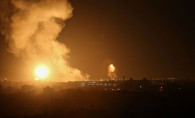Why threat of ISIS resurgence in Syria and Africa remains high
Why threat of ISIS resurgence in Syria and Africa remains high
Although the demise of the Islamic State terrorist group was announced by the international coalition combating ISIS in March 2019, the terrorists’ threat of resurgence remains high, especially in Syria, politically and security-fragile countries, and other conflict zones.
ISIS is an internationally-designated terrorist entity that emerged as a result of a conflict between Abu Musab al-Zarqawi, the late leader of an al-Qaeda-affiliate in Iraq (previously known as the Tawhid and Jihad group), and late al-Qaeda leader Ayman al-Zawahiri in 2014.
Recently, the terrorist group’s branches announced being responsible for attacks in Syria and African countries. For instance, ISIS announced on August 11 in its online magazine Al-Naba that it had been responsible for seven attacks in Syria, Iraq and Africa over a period of just one week, killing more than 55 people, the Syrian North Press Agency (NPA) reported.
The activities of ISIS terrorists have increased in Deir Ezzor, eastern Syria, using hit-and-run tactics by planting road-side bombs and attacking checkpoints. On August 29, 20 Syrian soldiers were killed and 10 others were injured in an attack launched by ISIS militants in the Syrian province of Deir Ezzor, said the Syrian Observatory for Human Rights (SOHR).
The ISIS members carried out this ambush on a bus carrying soldiers and then fled to the Badia (Syria’s desert area that covers 80,000 square kilometers and is administratively distributed over seven governorates: Deir Ezzor, Hama, Raqqa, Homs, Aleppo, Damascus countryside, and As-Suwayda, according to Alsouria Net).
Four days earlier in Raqqa, ISIS militants killed 10 pro-Assad soldiers at a checkpoint. Also, in early August, seven soldiers of the Syrian army were killed in another attack by ISIS on oil tanks in Hama, SOHR added.
In June 2023, Sputnik reported that 25 prisoners belonging to ISIS escaped from a prison controlled by pro-Turkish Turkmen in the city of Ras al-Ain in northern Hasakah Governorate.
UN experts said in a report on August 24 that ISIS in Syria and Iraq commands between 5,000 and 7,000 people, most of whom are fighters, noting that the group deliberately adopted a strategy of reducing its attacks to recruit more members.
The Security Council committee monitoring ISIS, al-Qaeda and associated individuals said in a report in July 2023 that the threat of ISIS remains high in the areas of conflict, warning against the revival of the militant group.
The committee added that the presence of people in the refugee camps could lead to the resurgence of ISIS if the current number remained unchanged for several years, as such places are a good environment for ISIS to disguise and re-organize its ranks after infiltrating among the locals.
The United Nation estimated that the number of internally displaced people (IDPs) in northwestern Syria is estimated at 2.8 million people. “There are approximately 1.7 million displaced people in 1,400 displacement sites, of whom 80 percent are women and children, and approximately 46,000 have special needs,” the UN added on February 11, 2022. Meanwhile, the number of displaced people in northeastern Syria is more than 200,000 people distributed in 77 camps, NPA reported on November 17, 2022.
The reason for intensifying attacks by ISIS in Syria is the security gap that was created in areas where the Syrian regime does not have control, Ahmed Ban, a writer and expert in the affairs of Islamist groups, said in comments to Jusoor Post.
“The local discrepancy in the goals and agendas of different powers in Syria like the Syrian Democratic Forces, Turks and Turkey allowed ISIS to take advantage of this discrepancy in the interests that create a gap through which the militant group moves easily,” Ban said.
Limited activities in Iraq
Unlike Syria, Iraq has witnessed a limited number of ISIS attacks. Maj. Gen. Matthew W. McFarlane, commander of the Combined Joint Task Force - Operation Inherent Resolve, told reporters in mid-August that ISIS fighters are “no longer militarily operational” in Iraq, Arab News reported. However, he said that the threat of ISIS’s resurgence remains in areas out the international coalition forces’ reach.
The Joint Operations Command in Iraq announced the killing of three ISIS militants in an airstrike in Salah al-Din Governorate, the Iraqi News Agency (INA) reported on August 23. The airstrike destroyed four hideouts, tunnels and caves used by ISIS members in this mountainous area.
French Sergeant Nicolas Mazier of the Air Parachute Commando was killed on August 28 by ISIS in Iraq while he was on duty with a unit supporting Iraqi forces in an anti-terrorist operation, the Elysee Palace announced in a statement. However, one week later, the Iraqi Counter-Terrorism Service arrested four terrorists belonging to ISIS in Kirkuk and Sulaymaniyah governorates. One of the arrested terrorists is an explosive expert.
Womb for terrorists
To prevent an imminent threat posed by the terrorist group, UN experts and the international community have warned against producing a new generation of terrorists from the womb of the Al-Hawl prison camp, where about 51,000 members of ISIS – the majority of whom are women and children – are currently being held by the Syrian Democratic Forces (SDF) in the Autonomous Administration of North and East Syria.
Ban clarified to Jusoor Post that it will not take a long time to produce a new generation of ISIS fighters in prison camps in northeast and northwest Syria, saying that children who were 10 years old when ISIS lost its control in Syria and Iraq in 2019 have now turned 14 years old and are capable of carrying weapons.
These camps are “a complete terrorist structure in which a large number of ISIS women indoctrinated children ideologically to prepare them for confrontation,” he added.
“Unfortunately, the coalition forces and the United States invested in this problem [through the unplanned withdrawal], leaving the Syrian Democratic Forces [alone], devoid of any effort to confront this huge number [of terrorists], with limited capabilities,” he said.
How ISIS expands in Africa
UN experts revealed on August 12 that ISIS doubled its number in Central Africa, like in Congo and Uganda, the Washington Post reported. The Allied Democratic Forces (ADF) had announced its affiliation to ISIS in late 2018 in the Democratic Republic of the Congo, and the main ISIS group accepted the allegiance in 2019, according to the US Department of State. This militant group has expanded its presence to Uganda, where it recently killed at least 37 people in an attack on a school in the western part of the country near the border with the Congo, Reuters reported on June 20.
As for the West African country of Mali, ISIS-affiliated terrorist groups have doubled the area under their control over the past year, UN experts revealed in a report, according to AP. In late June, the UN Security Council ended the decade-long UN Multidimensional Integrated Stabilization Mission in Mali (MINUSMA) due to “deteriorating” security conditions, the National reported.
The international coalition against ISIS announced in June that it will launch new operations in West Africa to prevent the expansion of ISIS’s influence in the region, Al Arabiya reported.
A report released on July 30 by the UN Secretary-General warned that the instability in African countries seeing wars and military coups, like in Sudan and Niger, would enhance the presence of ISIS. It added that ISIS fighters in Sudan are estimated between 100 and 200 fighters who facilitate providing logistics and funds in the war-stricken country.
The militant group also exists in other African countries like Somalia and Libya, the report added.
What are ISIS’s tactics to stay active?
The terrorist group has adopted a three-phase tactic to remain alive, the first of which is vexing and getting over its enemies to make them exhausted, and at the same time to bring about a state of presence to recruit more fighters and raise more funds, Ban told Jusoor Post.
The second phase is creating a state of chaos in some places to deviate the society’s attention away from the management of its basic capabilities and to fill the gap created due to a state of security vacuum, as has happened in fragile countries in Africa, especially the African Sahel region, he added.
“In the African Sahel region, there is fragility in the regimes’ forces and fragility in controlling the borders […] This allows the group to move between these borders through hit-and-run operations and imposing protection rackets to be able to recruit more fighters,” he explained.
The third phase is “the empowerment and controlling over certain [territories] like had happened when ISIS announced its ‘caliphate’ in Syria and Iraq in 2014,” the expert continued.
Nowadays, ISIS members have become aware enough and learned the lesson that control and empowerment in some places cost them a lot and led its opponents to come together to fight it, Ban said, giving the example of the international coalition against ISIS, which managed to end the terrorist group’s “caliphate” in 2019.
Ban clarified that the demise of ISIS that was announced in 2019 was regarding its empowerment and not the total end of its presence, adding, “Now the group is trying to restore its practical capabilities through qualitative operations in any number of regions to prove their presence and with the goal of going back to recruitment, especially because it lost many of its elements who fought against its opponents in many countries.”







